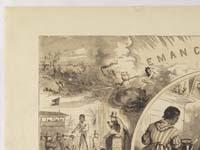You may have read the recently posted project update regarding the HINT project written by my colleague, Rachel Moloshok, in which she described our decision to reduce our number of annotated cartoons from more than 500 to approximately 125 cartoons. Even with this reduction, we’re still generating a lot of metadata. So, what are we going to do with all of it?
The metadata we’re generating contains lots of information about entities (persons and businesses or corporations), symbols, ideas, and the relationships between these. As Rachel described in her post, cartoons are encoded with publication dates; titles; artists, engravers, or other creators; persons or other entities depicted or mentioned; publishers; symbols; and more. You can imagine, this is a lot of information!
"Coney Island and the Crowned Heads," 1882 (Balch Broadsides: Satirical Cartoons [PG278])
One of the goals of the HINT project was to harness the linked data possibilities of the semantic web. We want our metadata to be more readable by search engines, like Google and Yahoo, etc., and our images easier to locate via web search tools. Since graphics are notoriously hard for search engines to find, this will help those researchers looking for more information about political cartoons discover our images and the HINT project. The beauty of the semantic web is that it allows for data to be shared across platforms and more easily processed by machines.
The first step in this goal was disseminating our metadata. We hoped to find a data-sharing forum by which to do this. Initially, we investigated SNAC (Social Networks and Archival Context), which is a prototype research tool from the Institute for Advanced Technology in the Humanities at the University of Virginia. SNAC is a project intended to gather and distribute archival metadata. Unfortunately, SNAC is unable to accept our metadata at this time, but the lovely folks running the project have expressed an interest in collecting our information at a later date.
However, we still need to find a way to get our metadata out there before the end of the grant period. We’re using TEI to encode our cartoons, so the TAPAS Project (TEI Archive, Publishing, and Access Service Project) seems like a good possibility. TAPAS is a platform from the TEI Consortium that will allow generators of TEI to share their data, as well as store and publish it, in such a way that it will be accessible for the foreseeable future. We are currently exploring contributing our metadata to TAPAS, along with some other alternatives.
"Emancipation," 1865 (Historical Society of Pennsylvania large graphics collection [V65])
Another prong of our efforts to make our data more easily accessible is utilizing RDF (Resource Descriptive Framework), another aspect of the semantic web. RDF is a particular descriptive data format which describes a relationship in triplicate form: subject-predicate-object. For example, “Thomas Nast drew ‘Emancipation.’” But rather than being a human-readable sentence, RDF is formatted in XML to make the metadata more easily machine-readable. In addition to the other modifications we’ve made to our DAMS (Digital Asset Management System), Collective Access (CA), we’re currently working to modify CA to output our data in RDF for easier sharing and finding. Please see our previous blog posts on the image viewer upgrades and utilizing TEI for more detail on some of our other CA modifications.
Even though the HINT grant period is winding down, we’re still busily working on the project. We hope you’ll continue to follow our progress. And don’t forget to check out the exhibit when Politics in Graphic Detail goes live on September 1. Keep your eye on HSP communications for links to the exhibit site and more information about HINT in the coming weeks!

